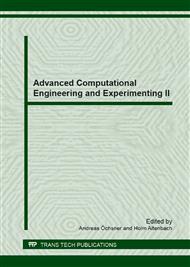p.67
p.81
p.87
p.93
p.99
p.103
p.111
p.117
p.125
Finite Difference Approximations of Elasto-Plastic Bending Problems: Layered Approach and Error Estimates
Abstract:
The finite difference method is applied to derive approximate solutions for the elasto-plastic bending of Euler-Bernoulli beam problems. The investigations are restricted to a simple exemplary configuration, i.e. a straight cantilevered beam with constant rectangular cross-section and linear-elastic/ideal-plastic material properties, loaded by a constant distributed load. Only finite difference approximations of second-order accuracy are considered and special emphasis is given to the influence of the load step, the number of layers, and the number of nodes. Based on comparisons with the analytical solution, clear recommendations can be given on the required parameters to obtain a certain accuracy in the numerical approach.
Info:
Periodical:
Pages:
125-130
Citation:
Online since:
June 2013
Authors:
Price:
Сopyright:
© 2013 Trans Tech Publications Ltd. All Rights Reserved
Share:
Citation:


